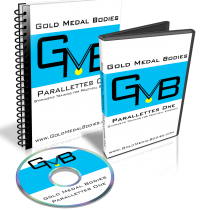Ryan Hurst from Gold Medal Bodies is here to show you how to build a training foundation with parallettes. This is the second in a three part series.
If you’ve been practicing your parallette push-ups, you’ve probably noticed that your arms and core feel a little different from what you’re used to. Maybe after a couple of days, you started to get the hang of it, and as your technique improved, you were able to perform the presses more easily.
That’s great, because it means that you’re ready for the next challenge: the most deceptively simple “abdominal” exercise of all time (that actually works way more than just your abs).
Enter the L-Sit
The L-Sit is a fundamental “hold” exercise that exemplifies the whole body tension generated by proper parallette training. Check out this video for a complete beginner’s tutorial on parallette L-sits:
The key point, as in the pushup, is the focus on bringing your elbow pits forward. This allows you to lift your chest up fully and pack down your shoulders. In this position you can bring your hips forward and lift your legs higher, which you’ll find makes the exercise much, much harder.
Strong core activation is initiated with an emphasized full exhale and lock out of the knees into the full L-sit position. If that’s too challenging to start with, you can begin by training the basic tuck position to achieve better form and technique. Try to keep your hips between your hands, or even further forward.
When you can hold the tuck for five reps at five seconds each, you’re ready to move on to the full L-sit.
To make the transition from tuck to L-sit, extend your legs out to a full locked position, fold back into the tuck and relax down. Instead of extending the feel, think of flattening the knees.
While holding the tuck for up to five seconds, extend into the L-sit for one second and return the the tuck. Repeat and gradually lengthen the time with your legs straight. Eventually, you want to work for 5 reps of 5 second holds.
Don’t get discouraged – the L-sit is tough!
You can practice this every day, but don’t neglect your recovery. Keep the volume low and remember to focus on technique above all else.
Once you’ve got a strong L-sit, you’ll have the core strength necessary to begin moving around on the parallettes. That’s what’s coming up in the next installment – so practice this technique and let us know if you have any questions.
Gold Medal Bodies has a full blown course on Parallette Training.



Comments
very well explained but wonder if one get this expertise at 50+yrs
Hey, just went to watch the video provided here and it said that it was private.